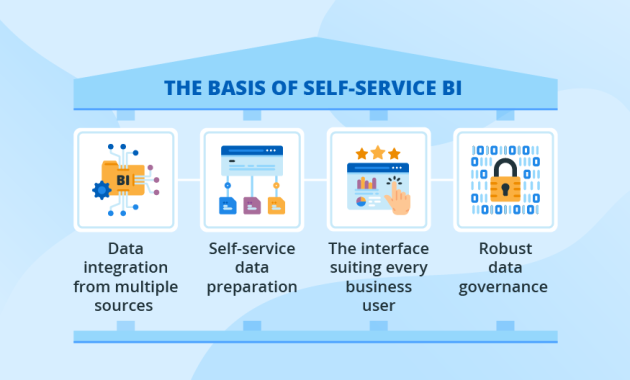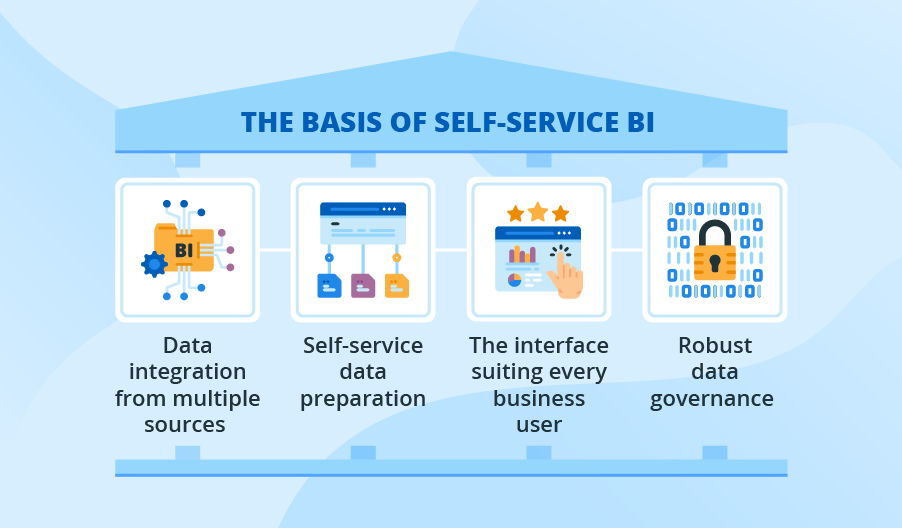
Self-Service Business Intelligence Software: A Risk Mitigation Strategy
In today’s fast-paced business environment, data is the lifeblood of informed decision-making. Organizations are increasingly reliant on their ability to collect, analyze, and interpret vast amounts of information. This is where self-service business intelligence (BI) software steps in, offering a powerful solution for empowering users to explore data independently. However, beyond its analytical capabilities, this software also plays a critical role in reducing risk. This article explores how self-service business intelligence software can be leveraged as a strategic tool for risk management, ensuring data-driven insights are not only accessible but also reliable and secure.
The Evolution of Business Intelligence
The evolution of BI has been marked by a shift from IT-centric, highly specialized systems to more user-friendly, accessible platforms. Traditional BI systems required significant technical expertise for data extraction, transformation, and loading (ETL), as well as for report generation. This often created bottlenecks, leading to delays in decision-making and limited access to data insights. The rise of self-service business intelligence software has democratized data access, putting the power of analytics directly into the hands of business users. This shift has profound implications for risk management.
Understanding the Risk Landscape
Organizations face a multitude of risks, ranging from financial risks to operational risks and compliance risks. Data can be a double-edged sword. While it provides valuable insights, it also introduces potential risks if not managed properly. These risks include:
- Data Quality Issues: Inaccurate, incomplete, or outdated data can lead to flawed analyses and incorrect decisions.
- Security Breaches: Unauthorized access to sensitive data can result in financial losses, reputational damage, and legal penalties.
- Compliance Violations: Failure to comply with data privacy regulations (e.g., GDPR, CCPA) can result in significant fines and legal repercussions.
- Data Bias: Biased data or flawed analytical models can perpetuate stereotypes and lead to unfair or discriminatory outcomes.
- Lack of Data Governance: Without proper data governance, data can become fragmented and difficult to manage.
How Self-Service BI Software Mitigates Risk
Self-service business intelligence software can be a powerful ally in mitigating these risks. By providing a controlled and governed environment for data exploration, these tools empower organizations to proactively manage risks associated with data. Here’s how:
Data Quality Control
Robust self-service BI software often includes features for data quality control. These features allow users to:
- Profile Data: Understand the characteristics of their data, identifying missing values, outliers, and inconsistencies.
- Cleanse and Transform Data: Correct errors and standardize data formats before analysis.
- Implement Data Validation Rules: Ensure data meets predefined criteria, preventing the use of inaccurate or invalid information.
By improving data quality, these tools help users make more reliable decisions. This directly reduces the risk of making decisions based on incorrect or misleading information.
Enhanced Data Security
Security is paramount in the age of data breaches. Self-service business intelligence software often includes security features such as:
- Role-Based Access Control (RBAC): Restricting access to data based on user roles and permissions.
- Data Encryption: Protecting sensitive data both in transit and at rest.
- Audit Trails: Tracking user activity to detect and investigate potential security breaches.
- Data Masking: Hiding sensitive information from unauthorized users.
These features help organizations protect their data from unauthorized access and reduce the risk of data breaches.
Streamlined Compliance
Compliance with data privacy regulations is a growing concern for businesses. Self-service business intelligence software can assist in compliance efforts by:
- Providing Data Lineage: Tracking the origin and transformation of data, enabling organizations to demonstrate compliance with data privacy regulations.
- Supporting Data Governance Policies: Enforcing data governance policies to ensure data is used responsibly and ethically.
- Generating Compliance Reports: Automating the generation of reports required for regulatory compliance.
By streamlining compliance processes, this software helps organizations avoid costly fines and legal penalties. This in turn reduces the risk of non-compliance.
Promoting Data Governance
Effective data governance is crucial for managing data risks. Self-service business intelligence software often includes features that support data governance initiatives, such as:
- Data Dictionaries: Providing centralized definitions of data elements, ensuring consistent understanding and usage.
- Data Catalogs: Enabling users to discover and understand available data sources.
- Data Lineage Tracking: Tracking the flow of data from its source to its final destination.
These features help organizations establish clear data governance policies, improve data quality, and reduce the risk of data misuse.
Reducing the Risk of Bias
Bias in data can lead to unfair or discriminatory outcomes. Self-service business intelligence software can help mitigate this risk by:
- Promoting Data Transparency: Making data and analytical models more transparent, enabling users to identify potential biases.
- Providing Tools for Bias Detection: Allowing users to identify and correct biases in their data and analyses.
- Encouraging Diverse Perspectives: Facilitating collaboration and knowledge sharing among diverse teams, leading to more comprehensive and unbiased analyses.
By promoting data transparency and providing tools for bias detection, this software helps organizations make more equitable decisions. This helps reduce the risk of discriminatory outcomes.
Key Features to Look For in Self-Service BI Software for Risk Mitigation
When choosing self-service business intelligence software for risk mitigation, organizations should look for the following key features:
- Data Connectivity: Ability to connect to various data sources, including databases, cloud platforms, and spreadsheets.
- Data Preparation and Transformation: Tools for cleaning, transforming, and preparing data for analysis.
- Data Visualization: Features for creating interactive dashboards and reports to visualize data insights.
- Data Governance and Security: Role-based access control, data encryption, and audit trails.
- Data Quality Tools: Data profiling, data validation, and data cleansing capabilities.
- Alerting and Notifications: Automated alerts for unusual data patterns or anomalies.
- Collaboration Features: Ability to share insights, collaborate on analyses, and communicate findings.
Implementing Self-Service BI for Risk Reduction: Best Practices
Successfully implementing self-service business intelligence software for risk reduction requires a strategic approach. Consider these best practices:
- Define Clear Objectives: Identify specific risk areas you want to address with the software.
- Establish Data Governance Policies: Create clear policies for data access, usage, and security.
- Provide Training and Support: Train users on how to use the software effectively and provide ongoing support.
- Monitor and Evaluate: Regularly monitor the software’s performance and evaluate its effectiveness in reducing risk.
- Foster a Data-Driven Culture: Encourage a culture of data-driven decision-making throughout the organization.
The Future of Self-Service BI and Risk Management
The future of self-service business intelligence software is bright. As technology continues to evolve, we can expect to see:
- Increased Automation: Automated data preparation, analysis, and reporting.
- Advanced Analytics: Integration of artificial intelligence (AI) and machine learning (ML) for predictive analytics.
- Enhanced Data Security: More sophisticated security features and data protection measures.
- Improved User Experience: More intuitive and user-friendly interfaces.
These advancements will further empower organizations to mitigate risks. This will also allow for data-driven decisions. This leads to increased efficiency and better business outcomes.
Conclusion: Empowering Data-Driven Risk Management
Self-service business intelligence software is not just a tool for data analysis. It is a strategic asset that can be used to proactively manage risk. By investing in the right software and implementing best practices, organizations can empower their employees to make informed decisions, improve data quality, enhance security, and streamline compliance. This ultimately leads to a more resilient and successful business. The ability of self-service business intelligence software to reduce risk is a crucial advantage in today’s data-driven world. [See also: How to Choose the Right BI Software for Your Business]

